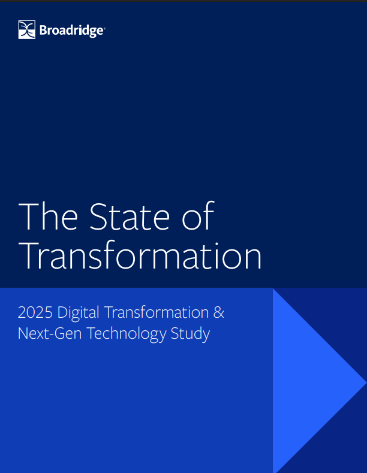Digital transformation 2025: What financial firms need to know
Posted by | Fuld & Company
New research reveals that financial institutions are deep into digital transformation—but data strategy, AI implementation, and legacy systems are proving to be the fault lines.

From cloud infrastructure to GenAI, and digital assets to cybersecurity, financial firms are investing heavily to modernize their operations and stay competitive. Yet a new study shows that even as budgets rise and digital ambitions grow, most institutions are still struggling to align strategy with execution.
The 2025 Digital Transformation & Next-Gen Technology Study, conducted by Broadridge in partnership with Phronesis Partners, surveyed over 500 global financial services leaders across wealth management, capital markets, and asset management. The findings reveal where firms are making progress—and where they risk falling behind.
1. Data strategy is the #1 success factor

Data has become the linchpin of digital transformation. Yet 47% of respondents say their firms are still dealing with data silos, and 40% report data quality issues. While 58% claim to have a clear data strategy, most are struggling to unify legacy systems and make datasets interoperable across the enterprise.
Key takeaway: Evaluate portfolio companies for data infrastructure weaknesses—especially if they rely on bolt-on tools or fragmented vendor ecosystems.
2. AI—and GenAI—is crossing into the core
72% of firms are making moderate to large investments in generative AI this year—nearly double the 40% in 2024. AI now ranks as the third-most used technology after cloud and cybersecurity, with 86% planning to increase AI investments in the next two years.
Why? AI is delivering tangible results:
- 68% say GenAI boosts employee productivity
- 51% cite improved reporting
- 50% see cost savings
- 35% expect ROI within 6 months
Still, skepticism remains: 74% believe GenAI needs tighter regulation, and 57% are waiting for the technology to mature.
Key takeaway: Scrutinize AI investments for realistic timelines and regulatory exposure. When evaluating deals, understand how GenAI is used—and whether it’s delivering ROI or just hype.
3. Cybersecurity is mission-critical—but resiliency is shaky
Cybersecurity tops the list of technology investments (87%), but many firms remain vulnerable. One-third say it would take them two to three days to recover from a cyber incident; another 30% say it would take a week or more.
Even with regulations like Europe’s Digital Operational Resilience Act (DORA) now in effect, only 48% of firms feel fully ready to comply.
Key takeaway: Assess cybersecurity not just in terms of tech stack, but also incident response capabilities and regulatory readiness. Cyber resilience is a due diligence essential.
4. Cloud dominates—but legacy tech is still a barrier
- 86% of firms use cloud technology in operations
- 84% plan moderate to large cloud investments this year
- Yet 46% say legacy systems hinder operational resilience
Despite enthusiasm for next-gen tech, foundational IT issues remain a drag on agility, speed, and scalability—especially in complex global institutions.
Key takeaway: In M&A scenarios, beware of hidden integration costs and operational risks tied to aging infrastructure.
5. Digital assets and blockchain are entering the mainstream
- 71% of firms are investing in blockchain/DLT (+12 pts YoY)
- 64% are investing in cryptocurrency (+13 pts YoY)
- 55% believe digital assets will become widely accessible
- 73% expect increased regulation
Digital assets are now seen less as experimental and more as inevitable. The strategic question is no longer “if” but “how” firms will participate—and with what safeguards.
Key takeaway: Monitor how portfolio companies or competitors are adopting digital assets. Expect new valuation models and regulatory scrutiny to reshape this space rapidly.
6. Personalization goals are stalled by silos
Although customer experience is a top priority, 59% of firms say internal silos are limiting their ability to personalize client engagement. Many are still sending paper mail to clients who opted for digital—a clear symptom of disconnected systems.
Key takeaway: CX tech promises are only as strong as a firm’s ability to execute. When evaluating tech platforms or customer strategies, ask: Are systems truly integrated—or just layered?
7. Digital maturity is more talk than traction
While 30% of firms believe they are digital transformation leaders, only 26% show leadership in core operational areas like product development, compliance, and the middle office.
Digital maturity varies widely by function:
- High maturity: Technology, fee management, client relationship tools
- Low maturity: Middle office, cash and liquidity management, regulatory reporting
Key takeaway: When assessing transformation progress—internally or in targets—look beyond strategic roadmaps. Operational execution tells the real story.
Bottom line for dealmakers and strategists
Digital transformation is no longer a differentiator—it’s a baseline. But execution is hard, and the complexity only increases the deeper firms go. For Private Equity and Investment Banking professionals, that means greater scrutiny of tech spend, platform readiness, data governance, and cybersecurity posture—especially in deals where digital capability is key to value creation.
Download the full report: 2025 Digital Transformation & Next-Gen Technology Study
Tags: AI & Analytics, Artificial Intelligence (AI), Data analytics, Disruption, Innovation, Market Insights



















